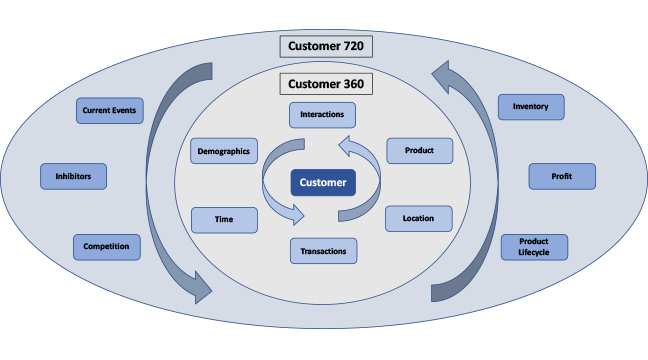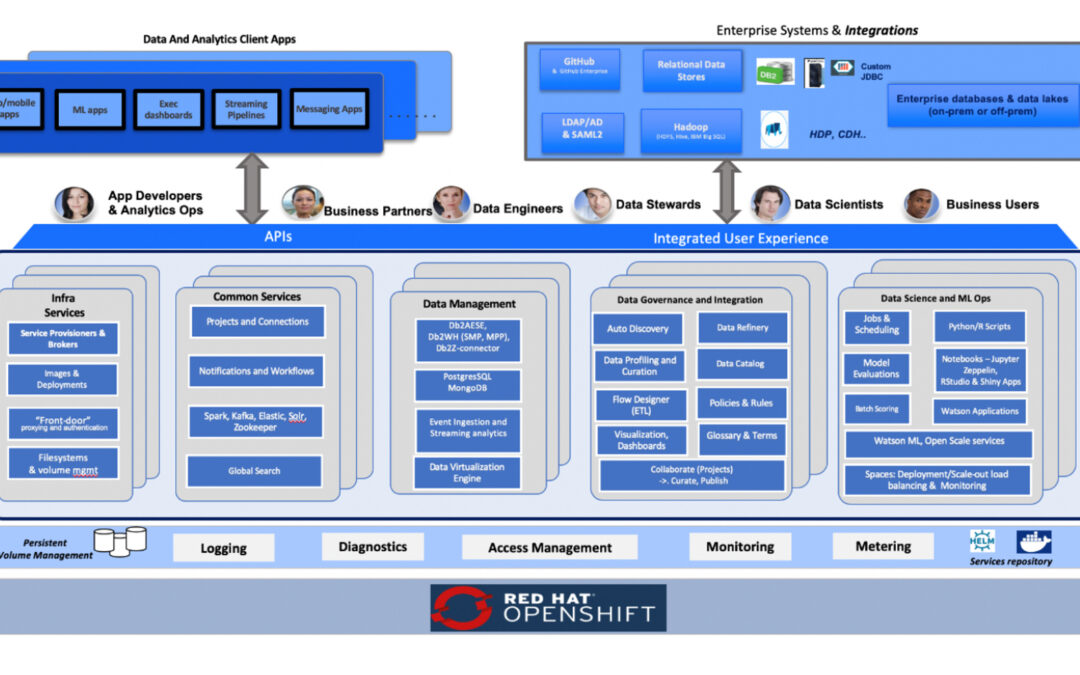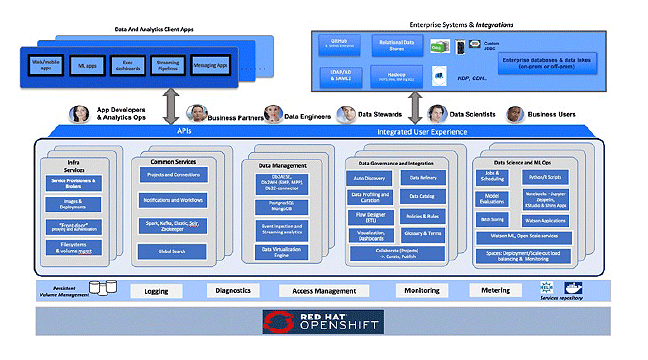Practice Director, Information & Analytics
Background: Customer 360 / Customer Data Platforms
The concept behind the Customer 360 perspective is not new. Successful organizations seek to understand their customer needs to a greater degree in order to elevate the customer buying experience, achieve higher customer satisfaction, and provide improved customer service. With ever-changing customer requirements, the question is, “How do you take the knowledge and customer perspective and drive even deeper insights?” These insights often need to integrate information in a completely new way, either because the value of information needs near-real-time data or the breadth of data necessary to reach a highly valuable outcome is not found within the walls of the organization.
There is a combination of many factors that cause organizations to only drill to a shallow depth. As with traditional data warehouses and/or data lake designs, many CRM (Customer Relationship Management) and CDP (Customer Data Platform) vendors have focused on bringing all necessary data into one singular golden repository. There are advantages to this design, but in a world of ever-changing customer needs and complex data sources with rapidly evolving interfaces, these technologies will always lag behind the timely data insights curve. The business demands for customer insights will continue to grow in order to deliver optimal value to the organization. Mainline, leveraging the IBM Cloud Pak for Data platform, has created design methodologies that are flexible and adaptable and drive comprehensive insights into customer behavior as well as optimal customer interactions.
Customer 360 – How it saved a client’s revenue stream amid COVID-19

With the evolution of Big Data and advancements in processing data, organizations can now take a deeper pass at the customer universe of data to better understand complex interactions between customer and product, and the organization as a whole. By taking the data processing to a deeper level, a retail client was able to predict and pivot revenue streams from big box store locations to online sales and save their revenue stream amid mandatory closures during the COVID-19 pandemic. This could only be done because the Mainline-designed customer insights platform had broad connectivity and capabilities far beyond the basic constructs of Customer 360.
Evolution of Customer Insights: Customer 720 Perspective
In 1985 skateboarding was growing in popularity, and national and international competitions were on the rise. Wooden ramps, called half pipes, showcased the skater’s talents as they performed ariel acrobatics. It was thought that spinning more than 360 degrees in the air before landing and continuing to the next trick was impossible until a skater named Tony Hawk was able to generate more height and complete two rotations, the 720. This evolution left the rest of the competitors shaking their heads, as their best tricks no longer could compete.
In the same manner, the IBM Cloud Pak for Data platform brings a multitude of capabilities that have revolutionized the competitive market and allow for the Customer 360 perspective to be broadened without the cost and complexity that would have been necessary, even two years ago. The Cloud Pak for Data Platform leverages functionality such as Data Virtualization to simplify data processing by analyzing data directly in the source systems versus needing to replicate data as with traditional data lakes and warehouses. This significantly cuts downtime to market of insights and increases the data value.
Also, Auto Categorization and Auto Profiling of data have mitigated manual intensive processes and helped to decrease the cost of data integration. At the same time, the IBM platform tools have capabilities of processing broader types of data, including semi and unstructured data, thus allowing the seamless marriage of insights optimized both for the best customer and organizational outcomes.
Mainline has implemented several successful projects expanding Customer 360 into areas such as Product Lifecycle and Accountable Care. (See Real World Success examples below.) Additional use cases have been successfully implemented across industries such as Higher Education, Medical Research, Insurance, Banking, and Financial Services.
Real-World Success: Examples of Customer 720
- Retail – Beyond Next Best Product – Profit Optimized & Personalized Recommendations
The notion of next best product is common on many sites and apps today. By infusing AI into the
process, human behavior can be predicted and aligned not just to a next best product, but to the lifecycle of the product and potential for profit. Linkage to product lifecycle, inventory, seasonality, demand, and other factors allow the organization to bring a more comprehensive perspective into the offer / follow-up offer if customer behavior indicates the product is not moving toward purchase. Follow-up may be a discount on the product if purchased in designated time period. This cannot be a standard predictive model or the consumer will identify and modify their behavior to capitalize and the organization’s profit will be minimized going forward. If dynamically built, then the method can be used not only to increase the purchase of additional merchandise but also to move stagnant inventory by discounting it with other products and thus mitigating lost profit.
Mainline has designed and implemented these next-level Customer 720 systems in retailers across a diverse set of products and customer groups. Many CRM systems provide a basic process around this concept but become problematic when taking the process to more of an enterprise perspective, because all necessary data is not within the CRM. The data often resides across multitudes of systems or even external to the organization. Mainline has leveraged the best of the CRM systems but augmented them with AI programming with tools such as IBM’s Cloud Pak for Data – Watson Machine Learning in order to create the comprehensive and expanded perspective and drive significantly higher product sales and profit thru the organization than is capable with a CRM based Customer 360 design.
When working with a retail customer last year, Mainline designed a solution matching buyers (with high propensity to purchase) with products moving toward end of life. Mainline helped the retailer to maximize profit by optimizing discounting for those aging products and selling them instead of having to take a significant profit loss offloading the products thru other means. The discounting strategy was aligned to the individual’s buying behavior and overall profit potential to the retailer. This interactive learning model was leveraged across the entire buying experience and increased both revenue and profit by looking at the individual‘s total purchasing potential, social media, and other value to the retailer as a whole (not at the individual transaction level). This second expanded perspective leveraged all the base information from Customer 360, but then extended the insights (another 360 degrees) to what we call the Customer 720 perspective.
- Healthcare – Optimize Care by Meeting the Patient’s Extended Needs
With Accountable Care evolving and healthcare organizations looking beyond the basic patient insights which can be managed within the organization’s Electronic Medical Record (EMR) system, novel insights are changing patient interaction and relationships with healthcare providers. One of the most complex and costly challenges facing healthcare organizations today is missed or last-minute cancellation of appointments. Getting to the root cause of this costly issue requires significant amounts of external and social data to decipher the “Why?” and mitigate the behavior.
In one Mainline customer’s case, the majority of patients missed appointments also disproportionately affected a particular population demographic as well. This underserved community was also having a much greater proportion of higher severity care, much of which could have been mitigated if identified and treated earlier. In order to combat this challenge, Machine Learning (ML) programs were built that married a broad spectrum of social, demographic, employment, weather, and other data in order to determine causality and create mitigation strategies. The data backing these processes was also complex, not of the highest quality, and not easily integrated. Mainline designed and implemented an end-to-end solution with IBM’s Cloud Pak for Data that ingested, processed, and then modeled and infused the outcomes back into the customer applications. There were a multitude of factors combined to form the main root cause, but one of the highest contributing factors was appointment timeframe and availability. The assumption is that individuals working an hourly position may be afraid of losing a job or pay and thus choose work over their healthcare needs. The organization was then able to create a plan to have extended hours on certain days to help mitigate this challenge, and the data is showing positive movement. This initiative, along with some transportation support, have decreased the missed appointments by 38% in the target group. Now the organization is leveraging this foundation to address other healthcare challenges in this target group.
Mainline was able to leverage its breadth of experience across industries to bring feature sets to the healthcare models, allowing the outcomes to be more meaningful than with the base data set and features originally targeted within the study. By crossing demographic features from a public sector success model over a similar population, Mainline brought quantifiable value to this healthcare organization and helped to change the trend for this underserved population.
The following diagram shows some examples of expanded data sets and broader perspectives that Mainline has leveraged to drive deeper customer insights and the Customer 720 design.

Key Concepts – Expanding Customer 360 Value Proposition
There are several major evolutionary leaps that have happened in the last few years that now allow for deeper insights into the Customer and relationship to the organization, its products, and its services. Many of these changes fall into areas that have been challenges in the past, such as Data Integration, Quality, Automated Data Discovery, Data Virtualization, Security/Data Obfuscation and Advanced Analytics/Machine Learning (ML) and Artificial Intelligence (AI). In the past, many organizations had to leverage multiple vendors in order to create end to end customer/organization integrated perspective. With multiple tools came complex skills and cost in order to step outside of the traditional Customer 360 base functions. IBM has created a unified, hybrid cloud solution with Cloud Pak for Data that allows the breadth of data processing and analytics functionality to be converged into a singular platform with a unified architecture. Why is this important? The cost of drilling deeper into complex customer/organizational behavior has been too high to accept in the past. Customer associations to topics like profit or inventory and the ability to dynamically interact to optimize touch points have been tested, but not practically implemented before the recent past.
Cloud Pak for Data has capabilities encompassing the collection/virtualization of data to the management and governance of data and then to the integration and advanced analytics/data science/ML and AI. These capabilities allow organizations to leverage both Open Source code and IBM enterprise solutions to create a custom-tailored platform specific to your organization’s needs. Common microservices such as logging and security are unified across the platform, and the containerized architecture (Kubernetes) is orchestrated by Red Hat OpenShift. The following diagram gives a high-level overview of the capabilities encapsulated within the Cloud Pak for Data platform.
More Information:
For more information on Customer, Data, ML and Automation solutions, contact your Mainline Account Executive directly or click here to contact us with any questions. Our experts can assist you with your digital transformation initiatives and help to improve customer experience and business outcomes.
You May Also Be Interested In:
BLOG: Data Management Using IBM Cloud Pak for Data and AI
BLOG: The Data Governance Corporate Marketplace
Learn more about Mainline’s Information & Analytics Practice.


